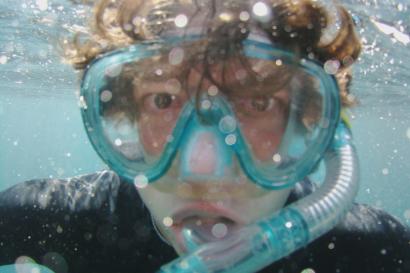One of the most exciting parts of snorkeling and diving in the Galapagos, is the opportunity to see sharks. The islands are home to hundreds of black tip reef sharks, white tip reef sharks, Galapagos sharks and even scalloped hammerhead sharks which are listed as an endangered species. When I've told people about seeing sharks in the water when diving or snorkeling, the first question they usually ask is if I was scared. With what you see in movies and television, this isn't a surprising question at all. Sharks are portrayed as blood-thirsty killers that eat anything and everything in their path, including humans. While sharks are equipped with impressive speed and strength, the danger they pose to humans is extremely exaggerated. In reality, you are more likely to be struck by lightning than bitten by a shark. The vast majority of shark bites are also unintentional, resulting from a person being mistaken for something else.
Being a marine science major, I’ve had the opportunity to learn the true nature of these amazing animals. Sharks are a very important part of marine ecosystems as they selectively prey upon weak and injured fish, helping to maintain a healthy population. There are also many sharks that are filter feeders meaning they only eat small organisms such as plankton. Unfortunately, humans kill more than 100 million sharks a year, and now sharks represent the largest group of threatened marine species on the World Conservation Union’s Red List of threatened species. Sharks often fall victim to by-catch, when they are accidentally caught and killed by nets and hooks intended for fish. Another large threat to sharks is shark finning. This is when sharks are caught, and their fins are cut off primarily to be used in shark-fin soup, which is considered a delicacy in some cultures. This practice is extremely hard to regulate, and often takes place illegally even in waters as supposedly well protected as the Galapagos islands. During the month I spent in mainland Ecuador, we were able to visit some of the fish markets on the coast and unfortunately saw that there were many sharks that were being caught and finned, including endangered species such as scalloped hammer heads (pictured below). Though it can be sometimes difficult to distinguish from sharks that were caught accidentally and those that were caught intentionally, there is a need for much more enforcement and regulation.
Shark conservation is made extremely difficult by the negative stereotypes surrounding these animals, and is why it is so important to raise awareness for the true value of these creatures. While in the Galapagos, I have had the opportunity to swim with white tip reef sharks, black tip reef sharks, Galapagos sharks, scalloped hammerhead sharks and silky sharks. In the water, sharks are often very timid around humans and swim away if you try to get too close. While seeing a shark for the first time was a bit startling, every time I’m transfixed by their grace in the water. I’ve come to love rather than fear sharks, and would advise anyone to take any opportunity to see sharks in the wild to take it. You surely find that sharks are much more deserving of awe than of fear.

Peyton Moore
<p>My name is Peyton, and I could not be more excited to study abroad. I love all things adventure, including hiking, surfing and skiing whenever I get the chance. I have had the travel bug ever since I spent a summer in Spain when I was in high school. I fell in love with the people, places and culture I encountered, and have not stopped chasing that feeling ever since.</p>








